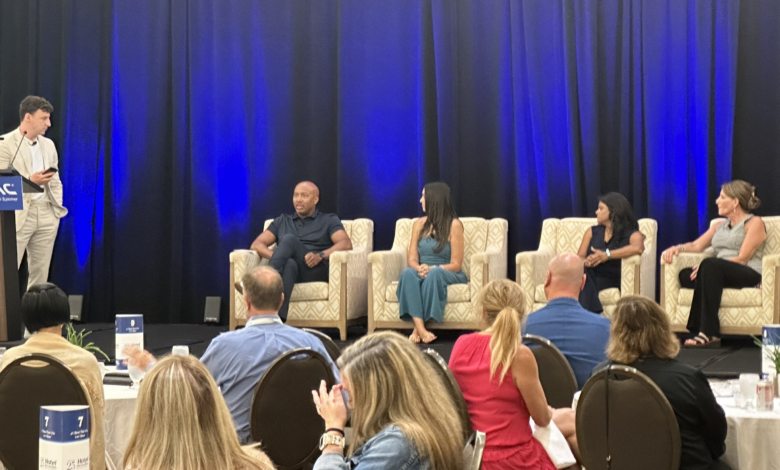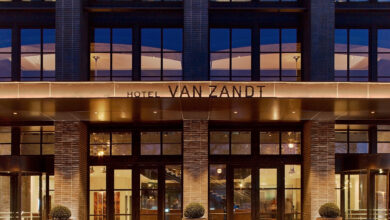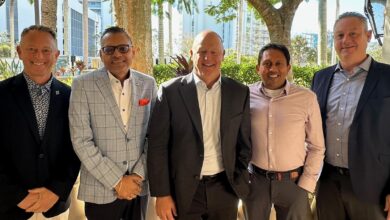
Transforming Guest Experience Through Design: Insights from BITAC Purchasing & Design Summer Event
By Gavin Fraser | July 29, 2024
The recent BITAC Purchasing & Design Summer event featured an engaging panel discussion exploring the intersection of hotel operations and design in enhancing guest experiences. Moderated by myself, the session delved into various aspects of hotel design, focusing on operational efficiency, sustainability, and the evolving needs of guests.
The lineup of panelists included the Chief Operating Officer of Pristine Hospitality, Arti Patel, the President of Stroud Group, Marji Waldman, the Principal of Woodmont Lodging, LLC, Elliot Estes, and the Founding Principal & Creative Director of White Lotus Design Studios, Chelle Maestas.
Enhancing Guest Experience through FF&E
Marji Waldman emphasized that despite evolving trends, the fundamental needs of guests, such as a good night’s sleep, remain paramount. High-quality mattresses and linens continue to be essential components of guest satisfaction. Connectivity is another critical factor, with recent shifts from USB to USB-C ports reflecting changing technology standards. Marji also discussed emerging products, such as full-body dryers, noting the mixed reactions to these innovations. While such products may be novel, their practical utility and acceptance among guests are still under evaluation.
Design Trends and Operational Efficiency
Arti Patel provided insight into how design trends are shaping operational efficiency and guest satisfaction. The extended stay model has gained traction, focusing on optimizing space and functionality. Arti described their experience with the extended stay design, highlighting the importance of integrating practical features like storage solutions and adaptable furniture. She advocated for closer collaboration between designers and brand representatives to ensure that designs not only meet aesthetic goals but also enhance operational efficiency. This collaboration can help avoid misalignments between design intent and operational needs.
Aesthetic and Functional Design Elements
Chelle Maestas highlighted recent trends in design that enhance guest experience from both aesthetic and functional perspectives. Multifunctional furniture is becoming increasingly popular, allowing for better utilization of space. For instance, wardrobes that combine storage with concealed appliances like refrigerators and microwaves streamline room functionality. Soundproofing has also gained importance, contributing to a more restful environment by minimizing noise from adjacent rooms or corridors. Chelle underscored the need for design elements that address both the visual appeal and practical comfort of hotel rooms.
Purchasing and Ownership Perspectives
Elliott Estes offered a broader perspective on how design decisions impact purchasing and ownership. He discussed the challenges of justifying higher costs associated with certain hotel designs, particularly when comparing properties with similar amenities but different price points. Elliott shared examples from his experience with asset management, noting that while design features like modern aesthetics and high-end finishes add value, they must be balanced with operational costs and expected revenue. He pointed out the need for careful consideration of how design influences both the guest experience and financial performance.
Challenges in Design and Operations Collaboration
Arti Patel addressed the challenges faced in ensuring that design and operational aspects are well-integrated. She noted that a disconnect often exists between the design teams and the operational realities of hotel management. Miscommunication between brand standards and on-the-ground management can lead to inefficiencies and issues with functionality. Arti emphasized the importance of having open lines of communication and involving all stakeholders early in the design process to avoid such problems.
Chelle Maestas echoed similar concerns, highlighting the importance of including operations teams in the design discussion to ensure that practical needs are addressed. She suggested standardizing elements like light bulbs to simplify maintenance and reduce inventory management issues. Chelle advocated for a more collaborative approach that integrates feedback from operations staff to enhance both the design and functionality of hotel spaces.
Sustainability Trends
Marji Waldman discussed the growing emphasis on sustainable products and practices in the industry. She noted that sustainability has become more mainstream, with many products now featuring sustainable attributes. However, she also mentioned the tension between cost and sustainability, especially when budget constraints challenge the implementation of green practices. Marji pointed out that regulatory changes, such as New York’s ban on small amenity bottles, are pushing the industry towards more sustainable practices.
Chelle Maestas highlighted that sustainability is becoming a standard expectation rather than a niche consideration. She noted that many products now offer sustainable options, and the cost of these products is decreasing. LED lighting has become the norm, replacing fluorescent options due to its energy efficiency and lower long-term costs.
Elliott Estes discussed the impact of sustainability on financial decisions. While sustainability can lead to long-term savings, such as through energy-efficient HVAC systems, there is often a conflict between upfront costs and the financial benefits of sustainable choices. Elliott described the challenge of balancing these considerations in the context of property investment and management.
Arti Patel emphasized the integration of energy-efficient technologies, such as infrared lighting, into brand standards. She highlighted the importance of operational efficiency as a form of sustainability, such as using technology to monitor and manage energy consumption.
Future Directions for Guest Experience
The panelists discussed how various factors influence the future of guest experience:
Chelle Maestas noted that the guest experience varies depending on the location and type of hotel. For example, guests in destinations like Las Vegas may prioritize public spaces and amenities over the room itself. Chelle suggested that while rooms should be comfortable and welcoming, the focus should also be on creating engaging public areas.
Arti Patel and Elliott Estes explored how technological advancements and design innovations are shaping guest expectations. The integration of mobile controls and efficient POS systems can enhance the guest experience by providing convenience and maximizing revenue opportunities. They acknowledged that while technology is evolving, there will always be a need to accommodate a range of guest preferences and technological comfort levels.
Overall, the panel discussion highlighted the complex interplay between design, operations, and guest experience. Emphasizing the importance of collaboration, sustainability, and adaptability, the discussion provided valuable insights into how hotels can leverage design to enhance operational efficiency and meet evolving guest expectations.






Get involved!
Comments